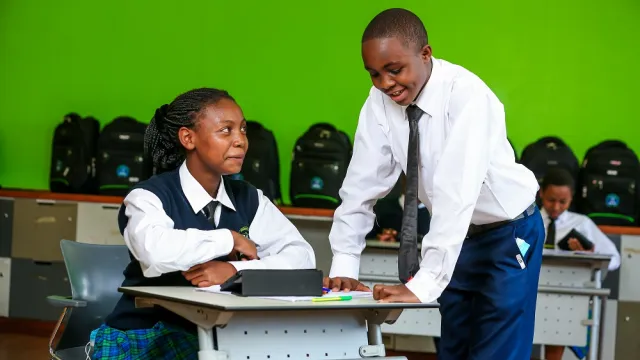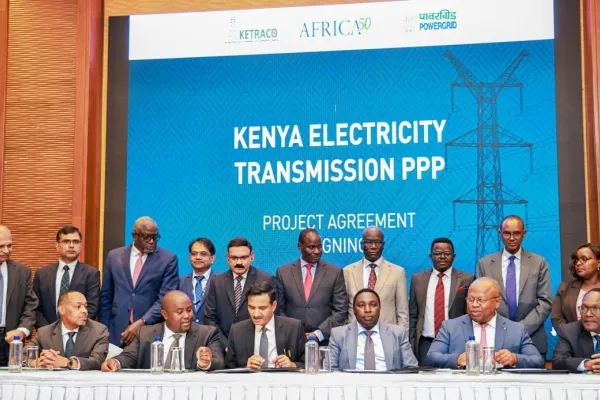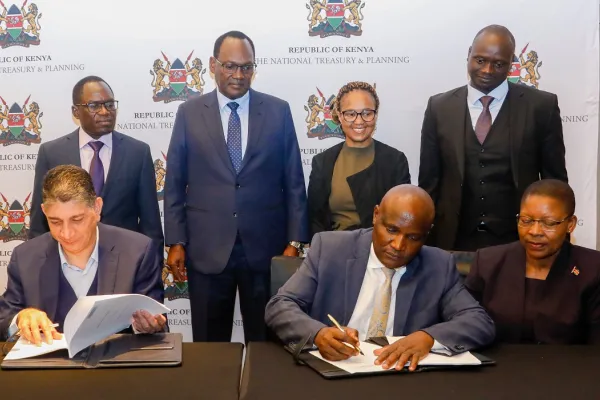iPads and beanbags; shaping the future of Kenyan classrooms

iPads and beanbags; shaping the future of Kenyan classrooms
As soon as you walk in, the polished wooden floors are strewn with colorful bean bags in the large room where floor to ceiling, windows give a lovely view of manicured lawns and immaculately tendered flowers.
Inside, a muffled buzz rents the air with young boys and girls perched in small circles on beanbags keenly thumbing through iPads, round tiny tables or in front of a Smart Tv hanging gracefully on one side of the wall.
Save for their school uniforms, you will be excused for assuming that this is the rec room of a Silicon Valley startup. But no, this is the layout of the M-PESA Foundation Academy's Resource Center.
It is one of the leading learning institutions in Kenya directly working to challenge the norms of how students interact with their learning environment.
This comes at a time the country's education system is still reeling from the shocks from the COVID-19 pandemic and as the school calendar finally expected to revert to the pre-pandemic schedule early next year.
Over these past two years, education policy makers, the private sector and parents have all been forced to re-think the learning process and structures that learners undergo in preparation for the job market.
To complicate matters further, the pandemic struck just as the government was rolling out the competence-based curriculum, CBC in public schools across the country.
All over the country both public and private institutions were forced to accelerate their digital learning plans to ensure that millions of learners maintained purposeful interaction with their teachers.
"After schools closed and our students had to go home, we went out of our way to equip every student with a learning device," explains Ms. Jackline Otula who runs curriculum development matters at the M-PESA Foundation Academy.
The Academy offers the International Baccalaureate Diploma Programme (IBDP), International Baccalaureate Middle Years Programme (IBMYP) and the International Baccalaureate Career-Related Programme (IBCP).
Students are drawn from every corner of the country. And the academy’s first priority is given to those from underprivileged communities.
"We also purchased solar gadgets to facilitate their continued online learning in areas with unpredictable power supply and teachers were provided with a Mac Book and an iPad as well as data to help them facilitate the learning process online," explains Ms. Otula.

In hindsight, school infrastructure, equipment and classroom density are some of the factors that can significantly impact educational outcomes. This is according to a recent study by the World Bank .
By studying more than 200 research papers, the study found that elements like good indoor air quality, thermal comfort, good acoustics and clean surfaces positively affected pupil's health and learning.
"The review highlighted the importance of light, color, sound, and micro-climate in engendering creativity but also space, flexibility, the availability of resources, and links to outside actors," explains the study in part.
"It stresses the link between design elements and pedagogical issues such as how to strike the right balance between freedom and structure in learning."
Allan Ngetich, who coordinates the Academy's resource center says the key focus is making learners feel included in the spaces they inhabit and interact on a daily basis.
"We have all kinds of students coming from all parts of the country and the idea is to make the space inclusive," he explains. "For instance, in every building we have wheelchair ramps to ease access for people with disability and the design of the lighting factors in consideration of the needs of persons with albinism."
Last year, the World Bank approved a request from the Kenyan government to restructure a Sh20 billion loan to avail additional funds for the construction of new classroom infrastructure.
The Kenya Secondary Education Quality Improvement Project scheduled to run until 2023 is meant to support 7,852 primary and 2,147 secondary schools in 30 counties economically and conditionally disadvantaged.
More than 1.6 million learners currently enrolled in Grade 6 are expected to transition into Upper Primary School in January next year. With the government pushing for a 100 percent transition rate across the education levels, the need for modern and digital education investment will therefore remain urgent in the near term.
September 8th, the International Literacy Day is now an opportunity to reflect and to rethink the fundamental importance of literacy learning spaces.
According to experts, the effectiveness of this new infrastructure investment will be predicated on addressing the evolving needs of students from all walks of life who meet in the classroom.
"We are looking to create and develop transformational leaders for Kenya and we realize that we need to meet the students at their respective points of need; how best students can learn at both the individual and the group level," explains Ms. Otula.



